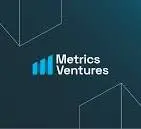Metrics Ventures Research Report | Akash Network: A Decentralized AI Computing Protocol with Both Narrative Speculation and Value Investment
Author: Firehand, Kevin, Charlotte
1 Introduction: The AI Track Has Become the Core Narrative of This Cycle
The fervor surrounding the AI track may not need further elaboration—the price performance alone is enough to overshadow all words. On February 23, 2024, Nvidia's stock price surpassed $800, with a market capitalization exceeding $2 trillion, making it the fastest company in history to grow from a $1 trillion to a $2 trillion market cap. In the Crypto space, AI track tokens have performed exceptionally well over the past few months, with leading tokens like RNDR, TAO, and FET all achieving over threefold increases. Each significant event in the AI field leads to a rapid growth of related tokens.
AI has become the most important technological revolution of this cycle, correspondingly becoming the number one track for speculative capital. Blockchain and artificial intelligence are actively exploring the possibilities of mutual integration, and the Crypto world will benefit from significant advancements in AI technology, driving rapid increases in related leading tokens. Perhaps a few months ago, we were still discussing the feasibility of combining AI and blockchain, but now such discussions seem less important; AI has already become the core narrative of this cycle, with market sentiment and capital enthusiasm overwhelming everything.
In our previous overall analysis of the AI track (What Sub-tracks in Crypto×AI Are Worth Attention Starting from Vitalik's Article?), we reviewed the four directions in which Vitalik has subdivided the AI track:
- AI as Participants: AI games, AI prediction competitions
- AI as Interfaces: Various AI applications
- AI as Game Rules: Autonomous Agent underlying protocols, zkML/opML
- AI as Goals: Decentralized data protocols, decentralized computing power protocols, and decentralized AI models
"AI as Goals" represents Crypto's decentralized transformation of AI, which is the most narratively attractive and speculative space. In terms of feasibility, although it currently cannot compete strongly with centralized businesses, many innovative projects with viable business logic have emerged. Projects that have already formed a moat will become strong investment targets in this cycle.
2 Track Overview: Decentralized Computing Power is the Core Direction for AI Track Layout
Among the many sub-tracks of Crypto×AI, decentralized computing power will be the direction that satisfies both narrative speculation and value investment.
First, the demand for computing power in the AI industry is rapidly increasing, with insufficient computing power and high costs becoming problems for the entire AI sector. On the supply side, the production of AI GPUs is monopolized by NVIDIA, with major players controlling AI computing power—part of it is used for training new models, while another part is leased out. Highly centralized and monopolized cloud platforms are controlling the pricing power of computing resources. On the demand side, the need for model training and inference is rapidly growing, with competition for computing power intensifying. Training small models and fine-tuning also require lower-cost computing support, and the large-scale adoption of AI applications is increasing the demand for model inference.
Secondly, among the many AI sub-tracks, decentralized computing power is the most closely integrated direction for the fusion of Crypto and AI, with the clearest business logic. The use of tokens to incentivize the supply of computing power, or the broader business logic of DePIN, has already proven feasible in the previous phase with decentralized storage tracks like Filecoin. Whether for Wrapper-type AI applications or Agent underlying protocols, the importance of tokens in the entire system is relatively low, while in decentralized computing power projects, cryptocurrencies are deeply bound to the entire business logic, truly leveraging Crypto's incentive effect to reshape the AI landscape.
With the recent Nvidia conference, decentralized computing power has ushered in a new wave of excitement, with leading projects showing impressive gains and a plethora of new computing power-related projects emerging. The current characteristics of the decentralized computing power track are: numerous projects, similar business logic, intense competition, and leading projects having a moat in the stability of computing resource supply and demand.
In terms of business logic, these projects are fundamentally similar: using cryptocurrencies as incentives to allow suppliers with CPUs and GPUs to provide computing power, enabling small and medium enterprises to use the computing power provided by lessors without permission. Token incentives keep the price of computing power far below that of centralized suppliers. Additionally, the requirements for decentralized model training in terms of communication and parallel computing are higher, and the use of computing is shifting from training to inference, so current projects are mostly focused on distributed inference, with a high degree of homogeneity.
Although the Nvidia conference has driven growth in a series of GPU-related projects, we anticipate that the future development of this track will further aggregate and centralize. After leading projects emerge, smaller projects will trend towards decline in the medium to long term. Whether in terms of computing power supply or users willing to adopt decentralized computing power, both are scarce. In a context of highly homogeneous business logic, resources on both the supply and demand sides will prioritize flowing to leading projects. Moreover, users require large-scale and stable computing power guarantees, and an overly decentralized track structure will be more detrimental to competing with centralized cloud service providers.
In summary, decentralized computing power will be a key direction for laying out the AI track. In the medium to long term, leading projects with certain moats will have sustained competitiveness. Under this logic, we believe Akash will be a core target for this track.
3 Akash Network: Fundamental and Token Economic Analysis
3.1 Fundamental Analysis
Akash Network is a decentralized cloud computing platform aimed at integrating underutilized computing resources globally through a peer-to-peer market, establishing a transparent marketplace where users can freely post resource demands and allow global resource suppliers to bid in real-time, thereby reducing the cost of cloud services. According to a report by Messari, the cost of equivalent hardware on Akash is significantly lower than that of other cloud providers.
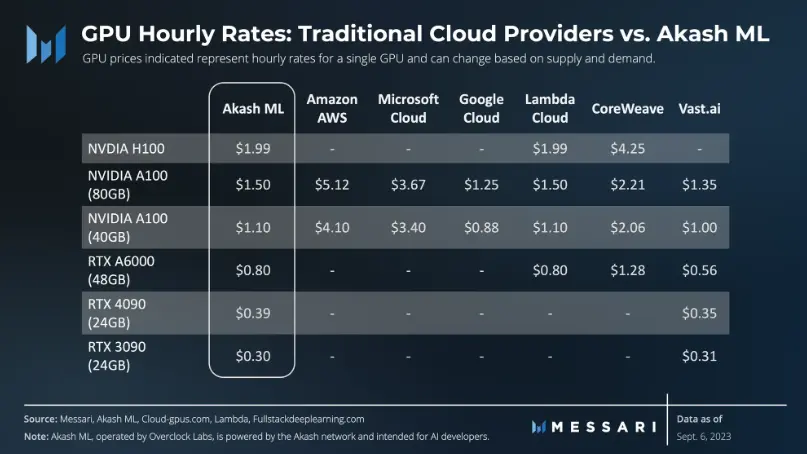
Founded in 2015, Akash launched its mainnet in the Cosmos ecosystem in 2020. Initially focused on CPU computing, Akash Network completed its mainnet upgrade 6 on August 31, 2023, and began supporting a GPU cloud market.
The supply side of computing power mainly comes from data centers, miners, and consumer-grade computing power. After mainstream public chains shifted to the PoS (Proof of Stake) mechanism, a large amount of idle computing power in mining farms became a problem to be solved. Akash Network is effectively utilizing these idle resources by collaborating with several large miners, having already secured a significant amount of high-performance computing resources equivalent to nearly 500 V100 GPUs, including 48 NVIDIA A100s added to the Akash GPU network by Foundry, the largest Bitcoin miner in North America. Personal computers scattered around the globe also harbor a wealth of underutilized low-end computing power. Currently, the Akash network has over 17,700 CPUs and 258 GPUs, and this number is continually rising. Additionally, Akash has launched specific incentive programs, such as a $5 million pilot incentive program, aimed at attracting more computing power providers to join the platform.
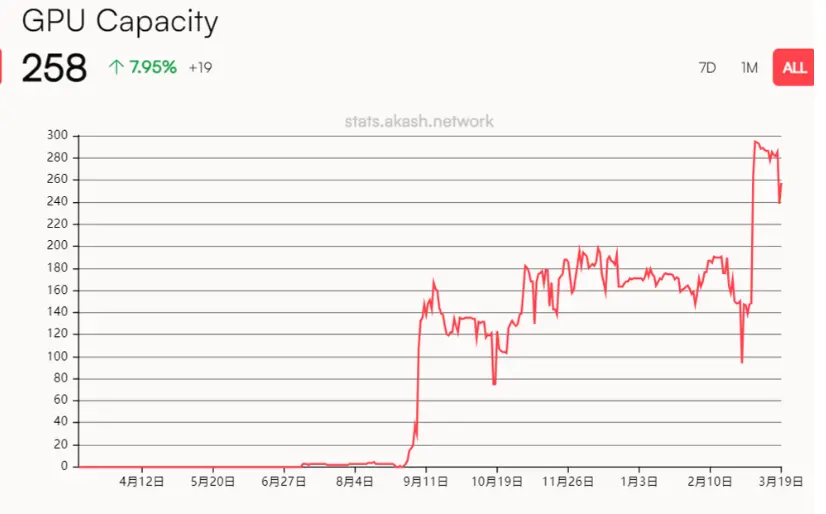
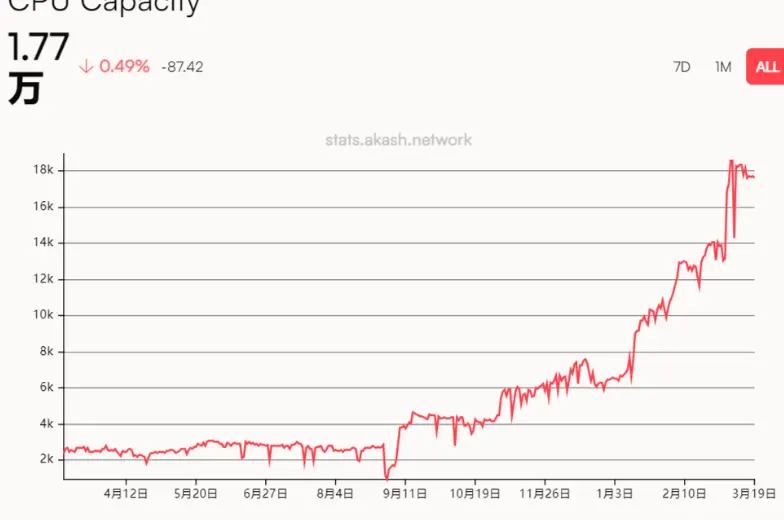
On the demand side, Akash Network is dedicated to attracting more developers by establishing its own open-source community, which not only helps strengthen its ecosystem's moat but also brings continuous innovation and development momentum to the platform. Furthermore, Akash is actively seeking collaborations with other decentralized AI protocols to expand its service range and enhance the platform's competitiveness. Currently, Akash has formed partnerships with two major decentralized layer protocols, Gensyn and Bittensor, which not only brings a substantial amount of fixed demand to Akash but also demonstrates its attractiveness and strength in the decentralized computing power market. After introducing GPUs in August 2023, Akash's daily rental volume has also seen a significant increase, with a cumulative total of 162,700 rentals completed, and daily revenue from rentals is continuously growing.
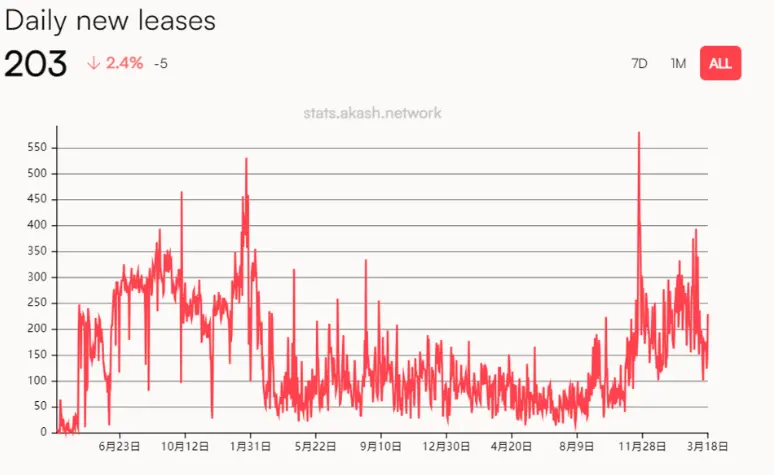
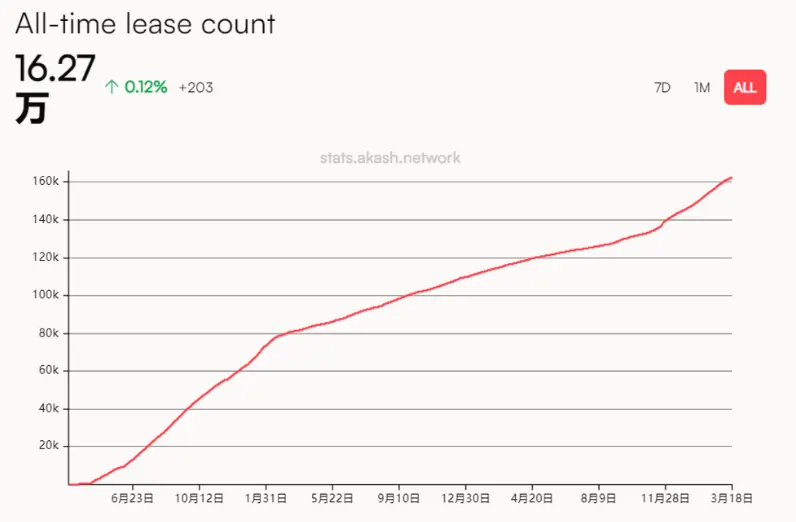
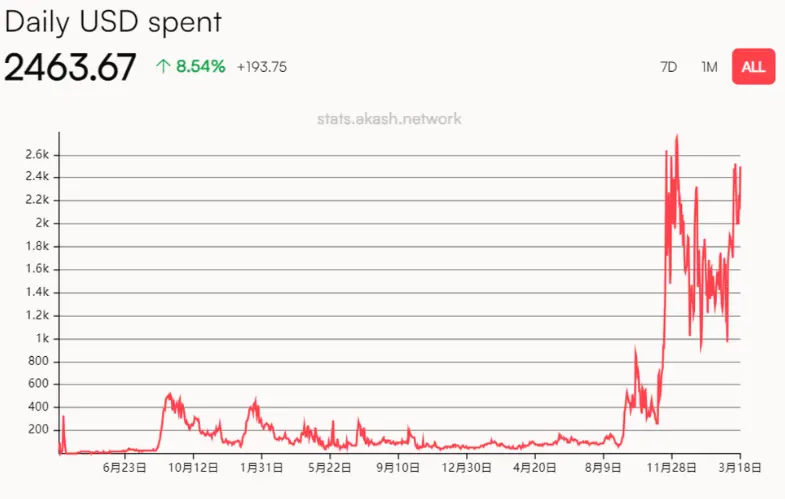
In matching supply and demand, Akash uses a reverse auction mechanism, where users create orders, and computing power suppliers bid on those orders. Users then select based on the suppliers' bids and other information, signing rental agreements.
In specific business operations, Akash Network's computing power is primarily used for data preprocessing and model inference, but recent attempts and developments are underway for model training. Since August 2023, Overclock Labs has begun training foundational AI models in collaboration with ThumperAI, ultimately aiming to create an open-source AI model named "Akash-Thumper" to be shared on Huggingface. If the model training is successfully completed, it will define the process for training models using distributed computing, attracting demand for the Akash network and increasing utilization.
With GPUs available and prices attractive, the only remaining barrier preventing developers from using Akash is the Crypto Barrier. Akash Network has implemented a series of measures to reduce user difficulty:
- Developed Cloudmos Deploy and Akash Console, allowing developers to manage instances on the network frictionlessly;
- Integrated Cosmos Swap on Metamask, enabling users to authorize AKT transactions on Metamask;
- Supports stablecoin payments, with Noble's upcoming launch of Cosmos-native USDC significantly lowering the entry barrier for developers.
3.2 Token Economics Analysis
The AKT token plays multiple key roles in the Akash ecosystem: as a staking medium to enhance network security, governance, a unit for rental settlement, and a benchmark for market pricing.
By staking AKT, users can participate in network governance, with voting weight depending on the number and duration of the tokens they stake, thereby promoting a decentralized decision-making process for the network.
AKT is primarily used to pay rental fees, with Akash regulating supply and demand through different fee rates (e.g., a 4% fee for AKT payments and a 20% fee for USDC payments) and an annual inflation rate of up to 13%, while allocating part of the inflation and fee income to a community pool for public funds, incentives, and potential token burns, ensuring the sustainable development and value circulation of the ecosystem.
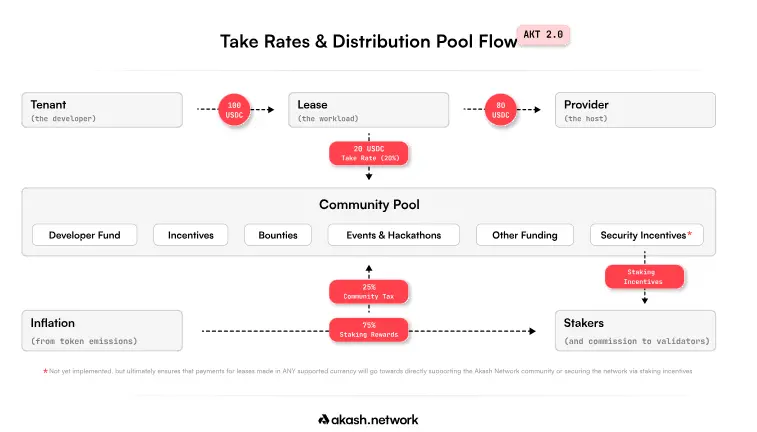
According to Coingecko data, as of March 20, 2024, the circulating supply of AKT is 230,816,799, and all AKT tokens have been fully unlocked, thus no longer facing significant unlocking sell pressure. The main increase in circulation currently comes from inflation incentives, with a maximum supply of 388,539,008. According to Stakerewards data, the current annual inflation rate remains around 15%. Approximately 133.49 million AKT is staked, representing a staking ratio of 57.8%, which is relatively high.
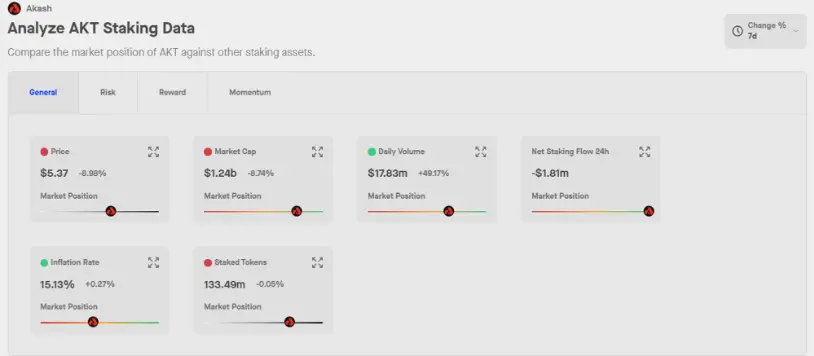
In terms of liquidity, Akash's main liquidity is concentrated on three centralized exchanges: KuCoin, Kraken, and Gate. Notably, AKT has not yet been listed on major exchanges like Binance, resulting in relatively low awareness in the Chinese-speaking community. However, AKT has been listed on Kraken, a leading exchange in the U.S., for some time and has also been listed on Coinbase. Historical cases show that projects like Bonk and Ondo often experience price rediscovery and significant growth after entering Coinbase's roadmap. Based on this trend, AKT's listing is expected to stimulate market enthusiasm and investor interest, thereby driving its price and market capitalization growth.
4 Competitive Landscape Analysis
Based on the previous analysis, the decentralized computing power track is highly competitive, with leading projects having strong moats. We believe that the two core competitive indicators for the decentralized computing power track are: computing power supply and computing power demand.
The importance of computing power supply is self-evident; having a greater quantity and higher quality of GPUs can more stably and efficiently handle more complex computing tasks. In a context of extreme scarcity of computing resources, this will become a moat for the platform. Computing power demand is equally important; a recent report from Coinbase pointed out that while the supply of computing power in decentralized platforms has significantly increased, platform revenues have not similarly grown, raising doubts about the market demand for decentralized computing. The interplay of computing power supply and demand will act as a positive flywheel, driving rapid growth of the entire ecosystem.
In this track, projects that share a leading position with Akash include Render, io.net, and Gensyn. Among them, Akash and Render were established earlier and were not initially designed for AI computing; Akash was initially used for general computing, while Render primarily focuses on video and image rendering. io.net is specifically designed for AI computing, but as AI has elevated the demand for computing power, all these projects have begun to lean towards AI development. Compared to Akash, io.net, and Render, which focus on AI inference, Gensyn is concentrating on AI model training, attempting to establish a verification layer that ensures the correctness of computations through probabilistic learning proofs, graph-based precise positioning protocols, and incentives.
From the perspective of computing power supply, Akash currently has 17,700 CPUs and 258 GPUs. In contrast, Render has not disclosed its hardware data, while io.net possesses more GPU computing power. As of March 20, 2024, io.net has 51,738 GPUs and 10,206 CPUs, and has formed partnerships with Render and Filecoin, gaining access to 4,458 GPUs and 197 CPUs from Render and 1,024 GPUs from Filecoin. The quantity and quality of computing resources far exceed those of Akash. However, it should be noted that io.net is currently attracting a significant amount of computing resources through highly attractive airdrop incentives, and the number of GPUs on the platform is rapidly changing. We still need to observe how much computing power remains on the io.net platform after the airdrop ends. In contrast, Akash's computing power comes from more stable and cooperative relationships, with computing resources consistently growing.
In terms of computing power usage, Render has not disclosed relevant data, but its current business focus remains on image rendering. Additionally, it has established a computing client to promote usage in the AI field, providing an API that allows other projects to access Render's GPU network to support AI inference, training, fine-tuning, etc. Currently, projects integrated with Render include io.net, Beam, FedML, and Nosana, with Prime Intellect and Exabits currently voting.
The overall network utilization of io.net is around 30%-40%, with computing power from Render and Filecoin almost entirely unused.
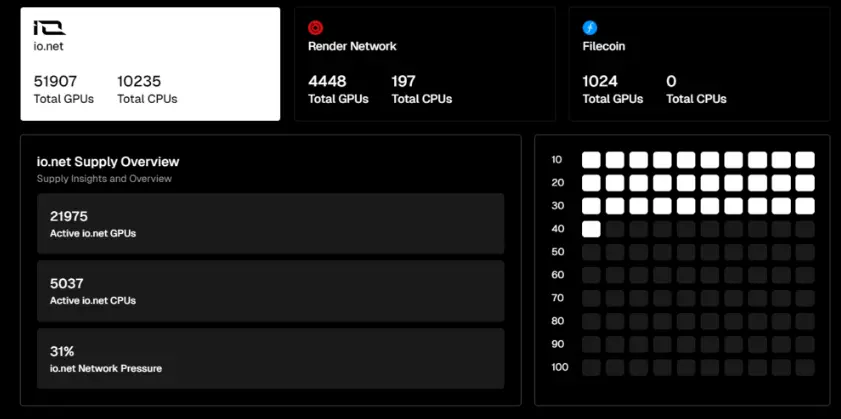
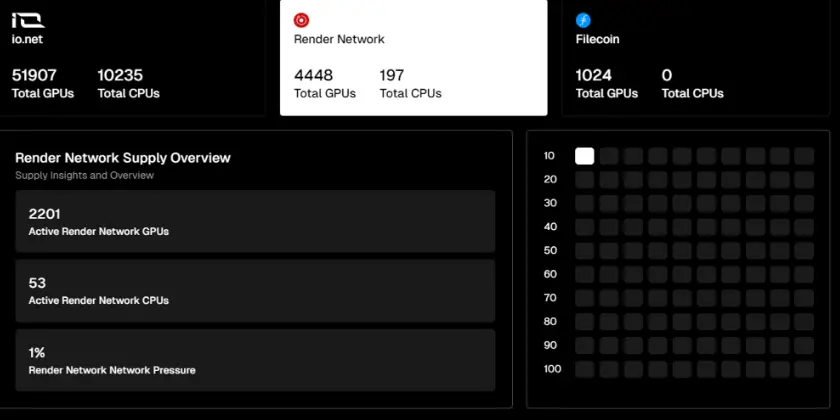
Akash Network's GPU utilization remains at around 40%-60%, which is a relatively leading level among decentralized computing power platforms. Recently, due to a significant increase in GPU computing power supply, utilization has seen a temporary decline. The CPU network's utilization also maintains a high level of 50%-60%.
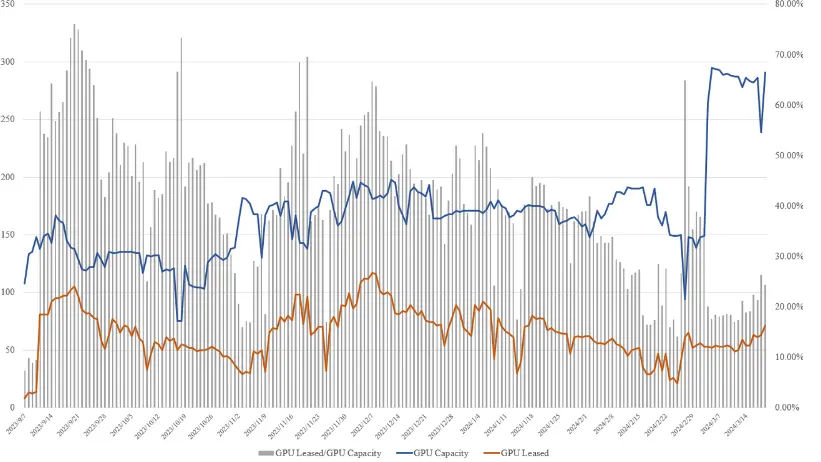
(Data source: Calculated based on Akashstats)
In terms of valuation, Akash currently has an FDV and MC of $1.2 billion, while RNDR's FDV is about five times that and its MC is about three times that. io.net and Gensyn have not yet issued tokens, with io.net's recent round of primary financing valuing it at $500 million. However, with the market sentiment towards io.net soaring, the price after the secondary token launch is expected to far exceed this value.

| | | | | | | | |---|---|---|---|---|---|---|
5 Conclusion
Based on the above analysis, Akash will be a target that aligns with the core narrative of this cycle and possesses medium to long-term investment value.
From the narrative theme and fundamentals, the AI track has become the main track of this cycle, with decentralized computing power being the core direction within this track. On one hand, this comes from the external attention and speculative sentiment towards computing power brought by Nvidia; on the other hand, it stems from the close integration of crypto and AI within the DePIN concept. Akash is the leading project in decentralized computing power, and in the next round of AI sector rotation, decentralized computing power will undoubtedly be one of the key focuses, while Akash will gain funding support due to its competitiveness and moat.
From a funding perspective, Akash has completed the unlocking of all investors and team tokens, and will not face significant sell pressure in this cycle, while the token staking ratio exceeds half. Based on the current token circulation and an inflation rate of 15%, approximately 94,609 AKT will be unlocked daily. With a token price of $5, the daily unlocking amount is about $500,000, resulting in minimal inflationary sell pressure. Additionally, on March 20, Coinbase listed AKT, which will open up the U.S. market for AKT, enhancing liquidity, and since AKT has not yet been listed on Binance, there remains a high expectation for further listings.
Future attention should be paid to Akash's developments in attracting computing resources and expanding customer relationships, especially being cautious of the risk of insufficient competitive advantages against similar projects, including io.net and Render, which are strong competitors to Akash. Particularly, io.net is currently attracting a massive scale of computing resources due to airdrop expectations. Akash originated from CPU computing; whether it can achieve sustained expansion of computing resources in GPUs and maintain stable use cases and customers is the core of its competition with other projects.



